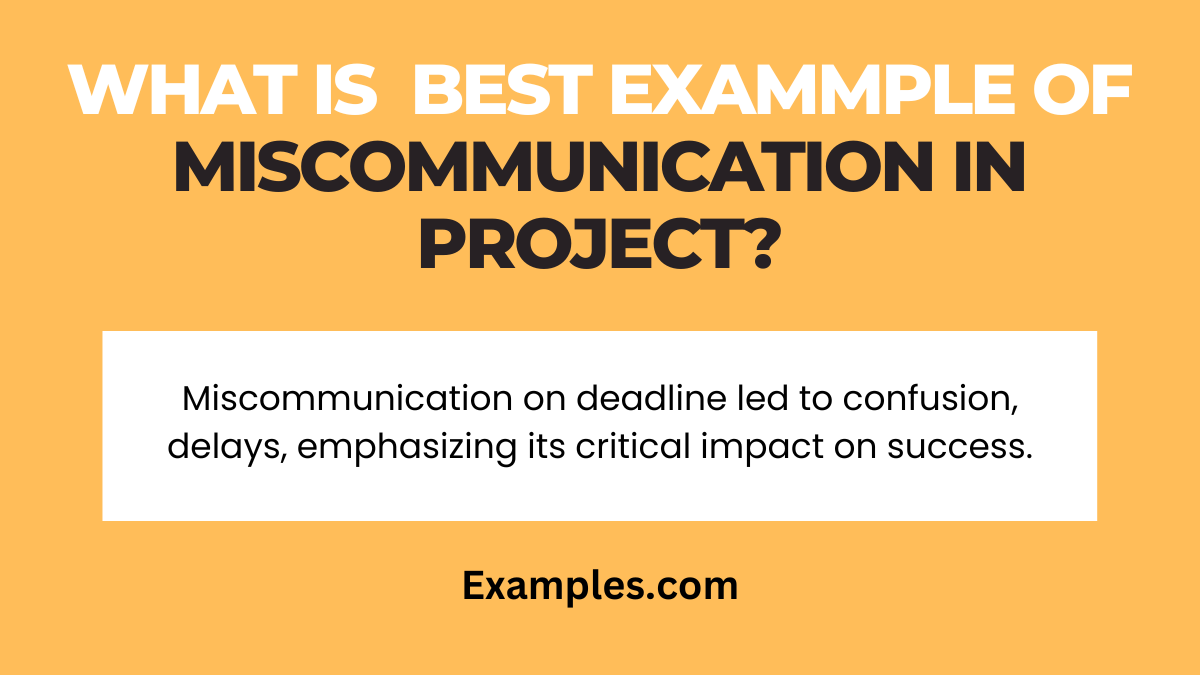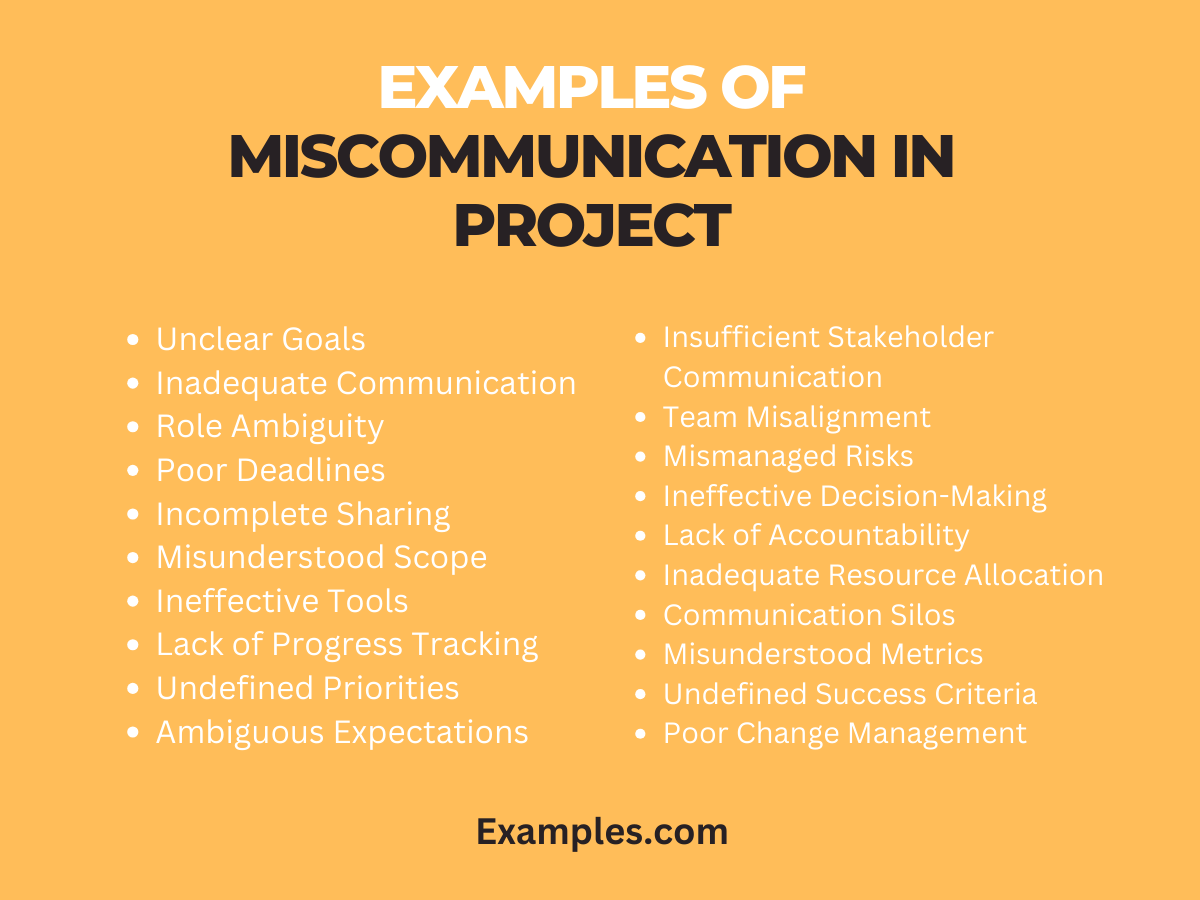19+ Miscommunication in Project Examples
Explore our comprehensive guide on miscommunication in projects, packed with illuminating examples to enhance your understanding. Unravel the nuances of effective communication and the pitfalls to avoid, ensuring seamless project collaboration. From common missteps to practical solutions, this guide navigates the intricacies of project communication. Elevate your project management skills and learn valuable lessons through communication examples, fostering success in your endeavors.
What is Miscommunication in a Project?

Miscommunication in a project refers to the misunderstanding or unclear transmission of information among team members, leading to confusion, errors, and potential project setbacks. It occurs when the intended message is not effectively conveyed or is misconstrued, emphasizing the importance of precise communication to ensure successful project outcomes.
What is the best Example of Miscommunication in a Project?

In a project where multiple teams collaborated, miscommunication about the project deadline emerged as a significant issue. While the project manager communicated a revised deadline internally, the information did not reach all team members. This resulted in some team members working towards the initial deadline, causing confusion, delays, and a need for urgent reorganization. This example underscores the critical impact miscommunication can have on project success.
20 Examples Miscommunication in Project

Explore the complexities of project miscommunication with this insightful guide on 20 common pitfalls. From ambiguous instructions to deadline misunderstandings, delve into practical solutions to enhance project collaboration. This resource provides clear explanations, actionable tips, and strategic insights, ensuring your projects stay on track and thrive.
- Unclear Project Goals:
- Avoidance: Clearly define and communicate project goals.
- Correction: Conduct a project goal clarification meeting.
- Inadequate Team Communication:
- Avoidance: Establish open lines of communication.
- Correction: Schedule regular team check-ins.
- Role Ambiguity:
- Avoidance: Clearly define roles and responsibilities.
- Correction: Conduct role clarification sessions.
- Poorly Defined Deadlines:
- Avoidance: Clearly communicate project timelines.
- Correction: Revisit and redefine deadlines as necessary.
- Incomplete Information Sharing:
- Avoidance: Foster a culture of transparent information sharing.
- Correction: Encourage team members to provide comprehensive updates.
- Misunderstood Project Scope:
- Avoidance: Clearly define and document project scope.
- Correction: Hold a scope clarification meeting.
- Ineffective Team Collaboration Tools:
- Avoidance: Choose and implement collaboration tools wisely.
- Correction: Provide training on effective tool usage.
- Lack of Progress Tracking:
- Avoidance: Implement a robust project tracking system.
- Correction: Regularly update and review project progress.
- Undefined Project Priorities:
- Avoidance: Clearly communicate project priorities.
- Correction: Conduct priority-setting sessions.
- Ambiguous Project Expectations:
- Avoidance: Clearly outline project expectations.
- Correction: Regularly assess and communicate expectations.
- Insufficient Stakeholder Communication:
- Avoidance: Establish clear stakeholder communication channels.
- Correction: Schedule regular stakeholder updates.
- Team Misalignment:
- Avoidance: Ensure team members share a common understanding.
- Correction: Conduct alignment meetings and workshops.
- Mismanaged Project Risks:
- Avoidance: Develop a comprehensive risk management plan.
- Correction: Regularly review and update the risk plan.
- Ineffective Decision-Making Processes:
- Avoidance: Establish clear decision-making protocols.
- Correction: Conduct decision-making training sessions.
- Lack of Accountability:
- Avoidance: Establish clear accountability structures.
- Correction: Hold individuals accountable through regular reviews.
- Inadequate Resource Allocation:
- Avoidance: Thoroughly assess resource needs.
- Correction: Reallocate resources as necessary.
- Communication Silos:
- Avoidance: Promote cross-functional communication.
- Correction: Break down silos through collaborative efforts.
- Misunderstood Project Metrics:
- Avoidance: Clearly define and communicate project metrics.
- Correction: Regularly review and explain project metrics.
- Undefined Success Criteria:
- Avoidance: Clearly outline project success criteria.
- Correction: Regularly reassess and redefine success criteria.
- Inadequate Change Management:
- Avoidance: Develop a robust change management process.
- Correction: Communicate changes effectively and provide necessary support.
What is the main cause of miscommunication in the project?
Miscommunication in a project can arise from various factors, and identifying the main causes is crucial for effective mitigation:
- Lack of Clarity: Unclear project goals, roles, or expectations contribute to miscommunication, leading to confusion among team members.
- Inadequate Communication Channels: Insufficient or ineffective communication channels hinder the flow of information, increasing the likelihood of misunderstandings.
- Poor Documentation: Incomplete or unclear project documentation can result in team members relying on different versions of information, causing discrepancies.
- Limited Feedback Mechanisms: Without proper feedback mechanisms, it’s challenging to ensure that messages are received, understood, and acted upon appropriately.
- Cultural and Language Differences: In diverse teams, cultural and language disparities may lead to misinterpretation, affecting the accuracy of conveyed information.
Understanding these causes is vital for implementing targeted strategies to prevent miscommunication and foster a more transparent and collaborative project environment.
What problem may arise as a result of miscommunication about a project schedule?
Miscommunication about a project schedule can introduce a range of challenges, including:
- Missed Deadlines: If team members receive conflicting information or unclear instructions regarding project timelines, deadlines may be missed, impacting the overall project schedule.
- Resource Allocation Issues: Poor communication can lead to misunderstandings about resource availability and allocation, resulting in inefficient use of resources.
- Client Dissatisfaction: If there is a disconnect between what was communicated and the actual project schedule, it can lead to client dissatisfaction and erode trust.
- Scope Creep: Miscommunication may contribute to scope creep, where additional tasks or requirements are introduced without a clear understanding of their impact on the project schedule.
To address these issues, emphasize transparent communication about project schedules, provide regular updates, and encourage team members to seek clarification when in doubt. Regularly reviewing and adjusting schedules as needed can also help prevent miscommunication-related problems.
What are the ways to reduce miscommunication in a project?
Mitigating miscommunication in a project involves adopting proactive measures and fostering a culture of effective communication:
- Establish Clear Communication Protocols: Define and communicate clear guidelines for project communication, including preferred channels, frequency, and escalation procedures.
- Encourage Open Dialogue: Create an environment where team members feel comfortable expressing concerns, seeking clarification, and providing feedback, promoting transparency.
- Document Project Details Thoroughly: Ensure that project goals, timelines, and expectations are documented comprehensively and made accessible to all team members.
- Utilize Project Management Tools: Implement project management tools that facilitate communication, collaboration, and real-time updates, reducing the risk of information gaps.
- Provide Communication Training: Offer training sessions on effective communication, emphasizing active listening, clarity in messaging, and the use of appropriate channels.
- Regular Team Check-Ins: Schedule regular team meetings to discuss project progress, address concerns, and ensure that everyone is aligned with project objectives.
By addressing these strategies, project teams can significantly reduce the likelihood of miscommunication, enhancing overall project success and team collaboration.
Is miscommunication a major cause of medical errors?
- Major Contributor: Miscommunication is a leading cause of medical errors.
- Types of Errors: Communication breakdowns can lead to errors in diagnosis, treatment, and medication administration.
- Patient Safety: Addressing communication issues is crucial for enhancing patient safety.
- Prevention: Minimizing miscommunication helps reduce the occurrence of medical errors in healthcare settings



